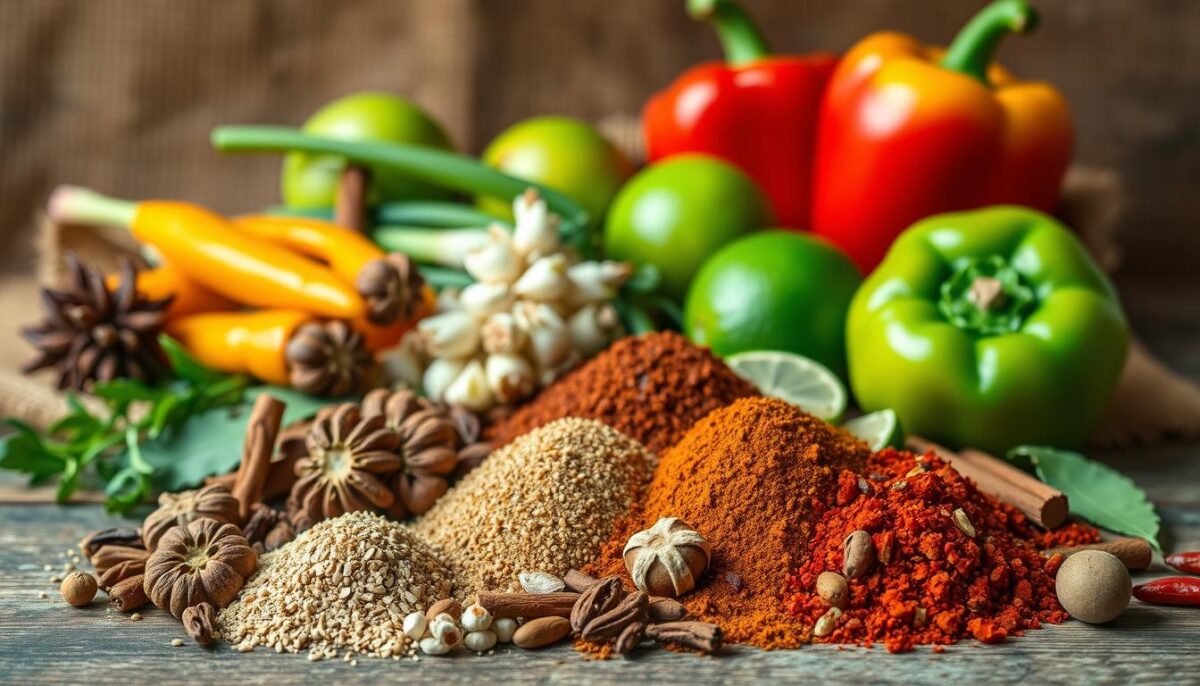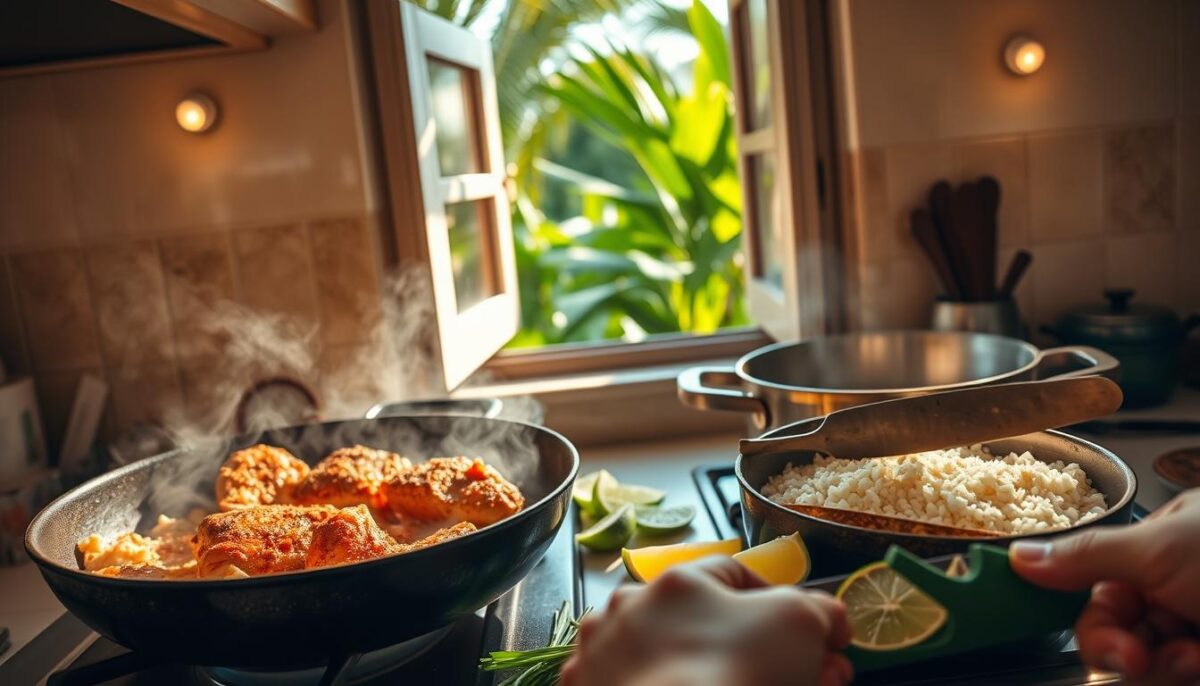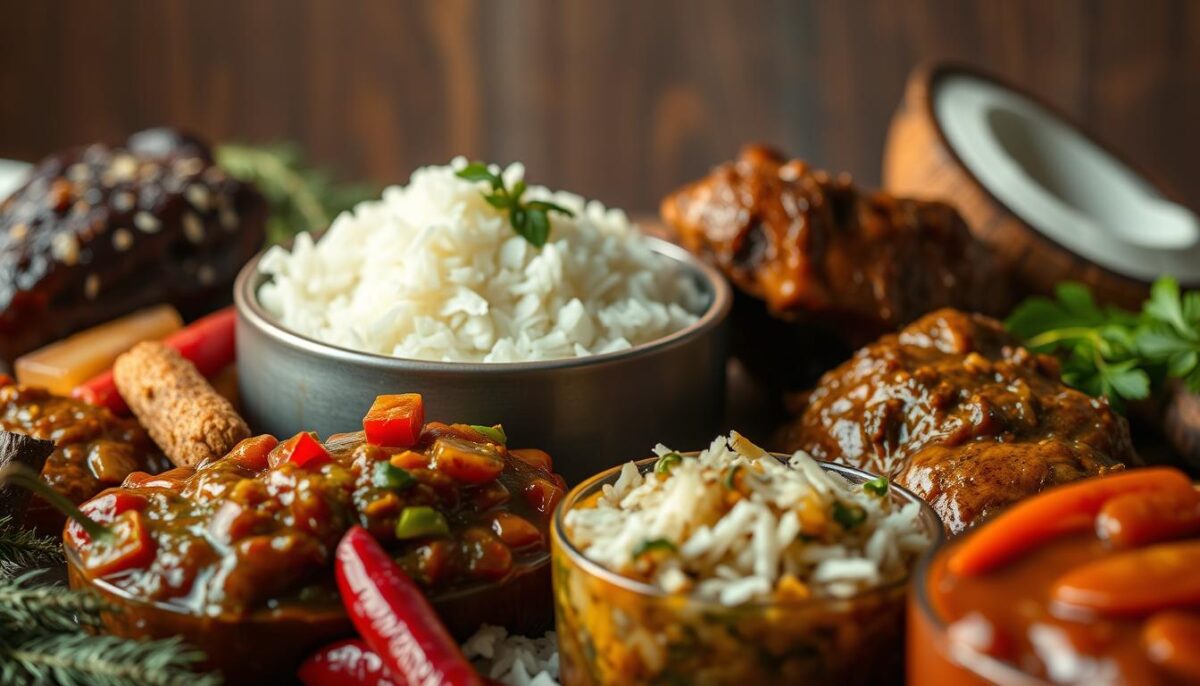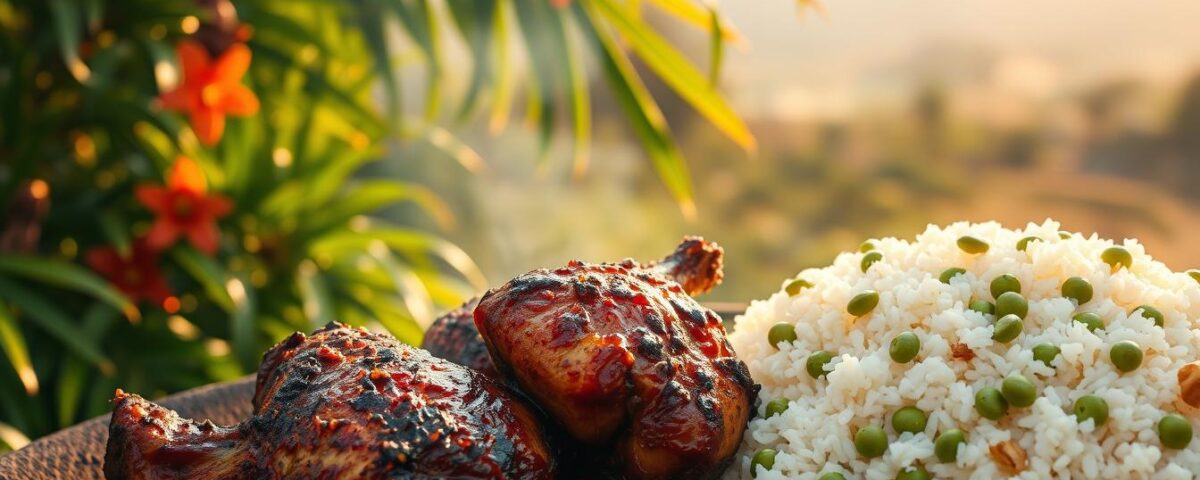
South African Flavors: Bunny Chow and Braai Explained
May 2, 2025
Belgian Bites: How to Recreate Waffles, Stews, and Beer Pairings
May 2, 2025I’ll never forget the first time I tasted the bold, smoky flavors of Caribbean cuisine. It was during a summer trip to Miami, where a friend’s backyard cookout introduced me to a dish that danced with heat, sweetness, and soul. That moment sparked a culinary obsession—one that led me straight to my kitchen, determined to recreate those vibrant tastes.
After countless trials (and a few fiery mishaps), I discovered the magic of balancing spices like allspice, thyme, and ginger. The real game-changer? A homemade jerk seasoning blended with fresh scotch bonnet peppers. Their fruity heat transformed ordinary grilled poultry into something unforgettable.
This recipe isn’t just about food—it’s a passport to sunshine on your plate. I’ve streamlined the process into a one-pot wonder that melds tender meat with fragrant grains. Whether you’re new to Caribbean cooking or a seasoned pro, I’ll walk you through each step like a trusted friend sharing family secrets.
Key Takeaways
- Create authentic Caribbean flavors using homemade spice blends and fresh ingredients
- Master a simplified one-pot cooking method perfect for weeknight meals
- Balance heat and sweetness with scotch bonnet peppers and tropical aromatics
- Adapt traditional techniques for home kitchens without special equipment
- Discover how layering spices creates depth in both protein and side dishes
Embracing Jamaican Vibes and My Culinary Journey
My love affair with bold Caribbean tastes began in a cramped Brooklyn apartment. A college roommate’s grandmother taught me to layer spices like building blocks – each adding depth to the next. That lesson became my kitchen compass.
My Connection to Caribbean Flavors
Timing transforms good meals into great ones. I learned to let seasoning work its magic during those crucial minutes while proteins marinate. A heavy pan becomes your best ally here – I always reach for my cast-iron skillet to build flavors through proper browning.
One secret? Letting sliced onion sizzle in hot oil until golden. This simple step creates a flavor foundation that carries through the entire recipe. When the aromas hit, I know it’s time to slide everything into the oven for that hands-off finish.
Why This Recipe Inspires Me
What keeps me coming back? The alchemy of patience and precision. Those 10 minutes spent perfecting the spice rub pay off when smoky-sweet notes bloom in the oven. This recipe taught me how seasoning isn’t just about heat – it’s about balance.
My trusty Dutch pan symbolizes the journey. From stovetop sizzle to steady baking, it handles every phase without fuss. That reliability lets me focus on what matters – creating layers of flavor that taste like sunshine.
Essential Ingredients for Authentic Caribbean Cooking
What makes Caribbean dishes sing? It starts with building blocks that hum with life. I learned early that great flavor comes from respecting each component’s role in the chorus.

The Vibrant Role of Jerk Seasoning and Spices
A good spice blend acts like a conductor. My mix combines garlic, thyme, and fiery bonnet peppers – their fruity heat waking up every bite. Allspice berries ground fresh add earthy depth you won’t find in pre-made jars.
Time transforms these spices. Letting meat soak for at least one hour allows flavors to dive deep. I’ve found bone-in cuts hold marinades better, becoming tender carriers for that signature kick.
Using Fresh Versus Store-Bought Ingredients
Fresh thyme makes all the difference. Its piney zing cuts through rich coconut milk better than dried leaves. For garlic, I smash cloves with the side of my knife – that burst of oils creates bolder foundations.
With bonnet peppers, control the heat by scraping out seeds. Too intense? Swap half with bell peppers. The goal? Balance that makes you reach for another bite, not a glass of water.
High heat sears in flavors during cooking. That sizzle when meat hits the pan? That’s your ticket to crispy edges and juicy centers. Every ingredient plays its part – miss one, and the symphony falters.
How to Prepare Your Jamaican Jerk Chicken Rice
The secret to bold Caribbean flavor lies in two phases: patient marination and thoughtful layering. Let me show you how these steps transform simple ingredients into a symphony of taste.
Marinating the Chicken to Perfection
Start by massaging your homemade spice blend into the meat. Freshly ground allspice and minced scotch bonnet peppers create that signature kick. For best results, let it rest overnight – those extra hours allow flavors to penetrate deep into the fibers.
Safety tip: Wear gloves when handling fiery peppers. Their oils can linger on skin for hours. A touch of brown sugar in the marinade balances the heat while promoting beautiful caramelization during cooking.
Setting Up Your Rice and Coconut Milk Base
The grain component needs equal attention. I combine full-fat coconut milk with chicken stock using a 1:1 ratio. This creates creamy richness without overwhelming the spices. Always rinse your grains first – it removes excess starch for fluffier results.
Here’s my pro move: Sauté diced onion in the same pan used for marinated meat. Those browned bits at the bottom? Liquid gold for flavor. Stir in your rinsed rice, then pour the coconut mixture slowly – like you’re coaxing the grains to drink deeply.
Timing matters. Set everything to simmer just before adding the meat. This ensures synchronized cooking where proteins and grains finish together. Follow these instructions closely, and you’ll achieve that coveted restaurant-quality texture.
Step-by-Step Cooking Process
Transforming your kitchen into a Caribbean escape starts with mastering two crucial techniques. Let’s break down the method that turns simple ingredients into a flavor-packed experience.
Searing, Browning, and Building Flavor
Heat your heaviest skillet until water droplets sizzle on contact. Place marinated protein in the dry pan – that initial sear creates a caramelized crust locking in juices. Listen for the satisfying hiss as surfaces make contact with hot metal.
After flipping, scrape up those browned bits with a splash of chicken stock. This deglazing step dissolves flavor gold into your cooking liquid. Here’s where scotch bonnet peppers shine – their fruity heat infuses the base without overwhelming other spices.

Integrating the Chicken with Rice and Beans
Combine rinsed grains and beans with equal parts coconut milk and broth. The creamy liquid should just cover the mixture – too much creates mush, too little leaves crunch. Stir once, then nestle seared protein into the grains like tucking in a child.
Watch the clock carefully during simmering. Perfect texture comes from precise timing: 18-20 minutes covered, then 5 minutes resting. Those final moments let flavors marry while preventing overcooked disappointment.
My favorite way to test doneness? Press a grain between fingers – it should yield softly without splitting. Remember: residual heat continues cooking even after removing from the burner. This attention to detail separates good meals from “wow” moments.
Tips, Variations, and Expert Tricks
Mastering Caribbean flavors means embracing flexibility. Whether you’re tweaking heat levels or swapping grains, these pro techniques help you own the recipe while keeping its soul intact.

Enhancing Flavor with Homemade Jerk Marinade
Skip bottled sauces. My marinade combines 2 tbsp freshly ground allspice with minced garlic and lime juice. For deeper flavor penetration, make shallow cuts in your protein before applying the mix. Always set aside ¼ cup before marinating – this reserved liquid becomes your basting gold.
Store-bought blends can’t match this freshness. Let the mixture rest overnight if possible. The ground allspice mellows while the acids tenderize. Need more kick? Add an extra tbsp of minced peppers to the reserved portion.
Customizations for Spice Lovers and Less-Spicy Options
Control the fire without losing complexity. For mild versions, swap half the bonnet peppers with roasted red bells. Spice enthusiasts? Double the peppers and add ½ tbsp cayenne to the dry rub.
| Heat Level | Pepper Adjustment | Stock Ratio for Brown Rice |
|---|---|---|
| Mild | 1 pepper + 2 tbsp bell | 1:1.25 liquid |
| Medium | 3 peppers | 1:1.1 liquid |
| Extra Hot | 5 peppers + 1 tbsp habanero | 1:1 liquid |
Prefer brown rice? Increase cooking liquid by ¼ cup and extend simmer time by 8 minutes. The nutty grains absorb flavors beautifully but need extra hydration. Test doneness by biting a grain – it should resist slightly like al dente pasta.
Bringing Authentic Caribbean Flavors to Your Table
Creating a memorable Caribbean dining experience starts with thoughtful presentation. Imagine golden grains dotted with red beans beside vibrant greens – this visual feast makes every bite taste better. Let’s explore how to turn your kitchen creation into a tropical celebration.

Serving Suggestions and Perfect Side Dishes
Pair your main dish with crispy fried plantains. Their caramelized sweetness balances spicy notes beautifully. For crunch, add a tangy slaw made with shredded cabbage, lime juice, and a pinch of allspice.
Try layering textures on the plate. Spoon coconut-infused grains first, then top with protein. Scatter black beans or pigeon peas around the edges for color contrast. A lime wedge tucked beside fresh thyme sprigs completes the picture.
A Few Extra Tips for a Complete Caribbean Meal
Boost flavor depth with simple toppings. Toasted coconut flakes add nutty richness, while extra allspice sprinkled tableside lets guests customize their heat level. Always serve peas or beans in small bowls – their earthy tones ground the meal’s brightness.
For drinks, blend pineapple with coconut water over ice. The tropical pairing cools palates between fiery bites. Remember: balance is key. Each element should complement without competing – like instruments in a steel drum band.
Conclusion
Crafting this dish taught me how every measured tsp and fresh ingredient builds magic. The earthy warmth of freshly ground spices blends with creamy coconut milk to create layers of flavor that linger like island sunshine.
Remember: quality matters. That extra minute spent grinding whole allspice berries? It transforms your seasoning from flat to vibrant. And when you pour rich coconut milk over steaming grains, you’re not just cooking – you’re curating an experience.
Every side of preparation counts, from marinating time to simmering heat. I’ve shared my kitchen-tested methods so you can skip the trial phase. Now it’s your turn – tweak the ground pepper heat or swap in almond milk if needed. Make it yours.
Ready to taste the tropics? Whip out your measuring spoons and embrace the flavor adventure. I’d love to hear how your version turns out – tag me with your creations using #SpiceStoryteller. Let’s keep those Caribbean vibes sizzling!
FAQ
Can I substitute store-bought jerk seasoning for homemade?
Absolutely! While I prefer blending my own spices for that bold, fresh kick, a quality store-bought mix works well. Just check the label for allspice, thyme, and a touch of heat—it’s the soul of the dish.
How long should I marinate the meat for maximum flavor?
I recommend at least 4 hours, but overnight is ideal. The longer it sits, the deeper those smoky, spicy notes soak into every bite. Patience pays off here!
What’s the best way to tone down the heat without losing flavor?
Swap scotch bonnet peppers with milder ones like jalapeños, or remove the seeds. A splash of coconut milk in the marinade also balances the spice while keeping things creamy and rich.
Can I use brown rice instead of white?
Definitely! Brown rice adds a nutty texture. Just adjust the cooking time and liquid ratio—it might need an extra 10-15 minutes and a bit more coconut milk or broth to stay tender.
Do I need a grill to get that authentic char?
Not at all! A cast-iron skillet on high heat works wonders. Sear the meat until caramelized, then finish in the oven. You’ll still get that crave-worthy crust.
What sides pair best with this dish?
Keep it tropical! I love grilled pineapple slices, fried plantains, or a simple cabbage slaw. For something hearty, black beans or cornbread add a comforting touch.
How do I prevent the coconut rice from sticking to the pan?
Rinse the grains first to remove excess starch, and use a heavy-bottomed pot. Stir once after adding the liquid, then let it simmer undisturbed. Fluff with a fork before serving!
Can I make this recipe vegetarian-friendly?
Yes! Swap the meat for tofu or jackfruit, and use a smoky jerk marinade. Add extra kidney beans or chickpeas to the rice for protein. The spices will still shine through.



